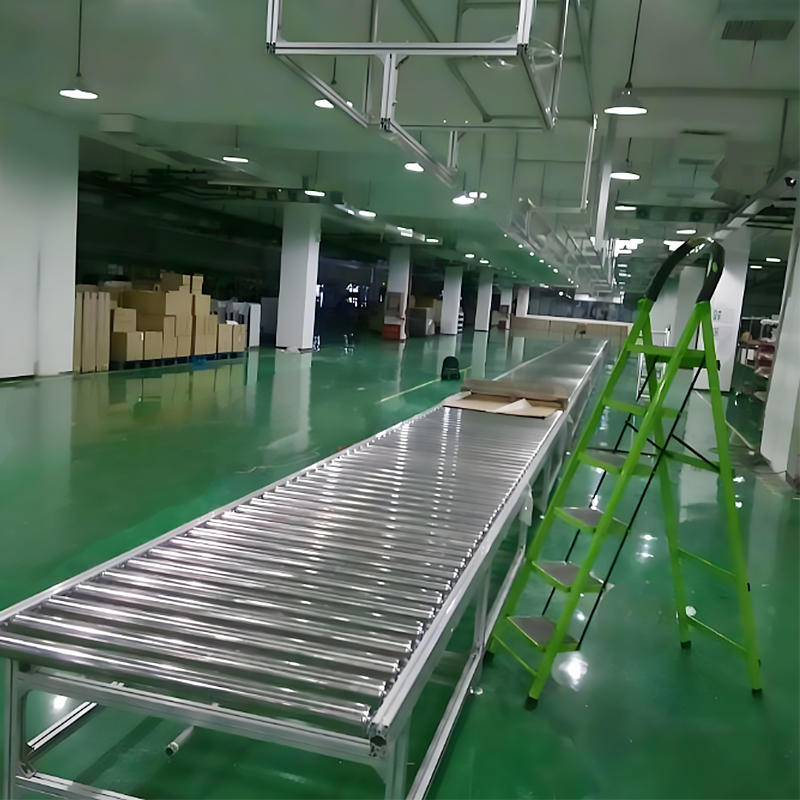Roller conveyors are favored in various industries for their durability, ease of maintenance, and the ability to handle goods with firm, flat bottoms, ultimately enhancing workflow and productivity. These systems facilitate the movement of items—ranging from lightweight packages to heavy pallets—with ease and precision.
Descriptio
Heavy Duty Roller Conveyors for Sale
Understanding the Mechanics of Roller Conveyors
Motorized, Active Roller Conveyors
Active or motorized roller conveyors infuse power into the system to actuate the rollers beneath the items in transit. So this propels the goods along the line at a controlled speed. Because combining strength with cost-efficiency, sections of active roller conveyors can integrate seamlessly with gravity-based or other types of conveyor segments.
Mechanism of Roller Conveyors
Employing steel rollers set within a track, so roller conveyors directly interact with the objects they move. Such as boxes, cartons, totes, or pallets. Besides, these robust systems excel in transporting heavier items that are non-sensitive to impact and have a firm, flat base for stable conveyance.
Manual, Gravity-Driven Roller Conveyors
For cost-conscious operations, gravity roller conveyors are a stellar choice. And manual intervention shifts loads over rollers or skatewheels positioned in stationary frames. Besides, these systems can operate on an even plane, allowing for straightforward, minimal-effort directional motion.
Elevation and Flow in Gravity Conveyors
Gravity conveyors typically incline downwards to allow items to move fluidly, taking advantage of gravitational force – hence their designation. These systems are particularly effective for moving rigid-bottomed boxes, cartons, and totes. The sizing and spacing of rollers or skatewheels can vary and to maintain continuity of motion, at least three rollers should be in contact with the item at any instance.
Product Data

Detailed Overview of Roller Conveyors

Composition and Materials:
Roller conveyors consist of core components such as rollers, frames, and support brackets, along with essential drive elements. The rollers that facilitate the movement of items on the conveyor come in various materials including carbon steel, stainless steel, aluminum, PVC, and plastic steel.
Drive and Speed Regulation:
Drive options for roller conveyors include reduction motor and electric roller drives. To adjust the conveyance speed, the systems use either frequency conversion or electronic speed regulation methods.
Industrial Uses:
These roller conveyors are versatile and find applications in industries like electronics, food and beverage, packaging, machinery, tobacco, pharmaceuticals, rubber and plastics, automotive, and logistics. Different transmission methods, such as single or double sprocket, O-belt, flat friction belt, timing belt, or line shaft, match specific operational requirements.
Features:
Ease of integration stands out as a key feature of roller conveyors, allowing for seamless connectivity and transition. Besides, multiple roller conveyors’ lines can be combined with other conveyance systems to form intricate logistical layouts, accommodating a variety of processing needs and facilitating sorting and merging functions.
Customization Parameters:
For tailored roller conveyors solutions, please provide:
1. The dimensions and height of items to be transported.
2. The weight of each item.
3. The base condition of the items.
4. Any special environmental conditions (e.g., humidity, temperature extremes, chemical exposure).
5. Specification of whether the roller conveyors system requires motorization. For steady movement, items must maintain contact with at least three rollers, and pallets may be necessary for soft bagged items.
Roller Specification Guidelines:
1. Roller Size: Select rollers that are appropriately wide for the items, typically the item width plus 50mm is recommended.
2. Roller Wall and Shaft: Choose based on the load distribution across the rollers. At the same time, calculate each roller’s load capacity to determine the wall thickness and shaft diameter.
3. Material and Treatment: The roller materials and their surface finishing (galvanized steel, stainless, rubber-coated) depend on the specific conveyance environment.
4. Installation Method: Pick the roller’s installation style—spring-loaded, internal tooth, flat tenon, or through-axle pinhole—based on the overall system’s configuration. For curved sections, roller dimensions and taper will hinge on the load dimensions and the curvature radius required.
Guide to Conveyor Roller Varieties and Selection Techniques
Conveyor Roller Types
1. C-Type Roller: A versatile choice for standard conveyor conditions, this is among the most prevalent roller types.
2. Z-Type Roller: Ideal for heavy-duty materials such as coal and cement, these rollers offer a high load capacity with minimal material wear.
3. Y-Type Roller: Best for instances where the direction of force varies. Besides, the inclined ends of Y-type rollers aid in material gathering and dust prevention.
4. V-Type Roller: Optimal for roller conveyors utilizing hydraulic or electric motor drives. Meanwhile, these can operate with flat belts to transport materials at various angles.
Selection Considerations for Conveyor Rollers
1. Material Properties: Roller selection should align with the material’s characteristics and the conveyor’s operating conditions, considering aspects like explosiveness, flammability, and corrosiveness, as well as temperature sensitivities.
2. Conveyor Usage Conditions: Choose rollers that best fit the roller conveyors’s applications; for instance, Y-type rollers for inclines or H-type for high-speed operations.
3. Roller Dimensions: The appropriate roller size is dictated by the roller conveyors’s design and operational demands to meet the material transport needs effectively.
4. Roller Quality: Inspect the construction materials and intrinsic quality of the rollers to ensure they possess the necessary load capacity and longevity.
5. Additional Factors: Factors such as roller length and overall durability should also be considered in the selection process.
In conclusione
The discourse covers a brief on different conveyor roller models and their selection strategies. So opting for the right roller ensures the roller conveyors’s proper functionality and seamless material transit. Selection should be informed by various considerations including material type, application scenarios, appropriate dimensions, and roller quality. While also ensuring you choose models that offer stability and prolonged service life.





